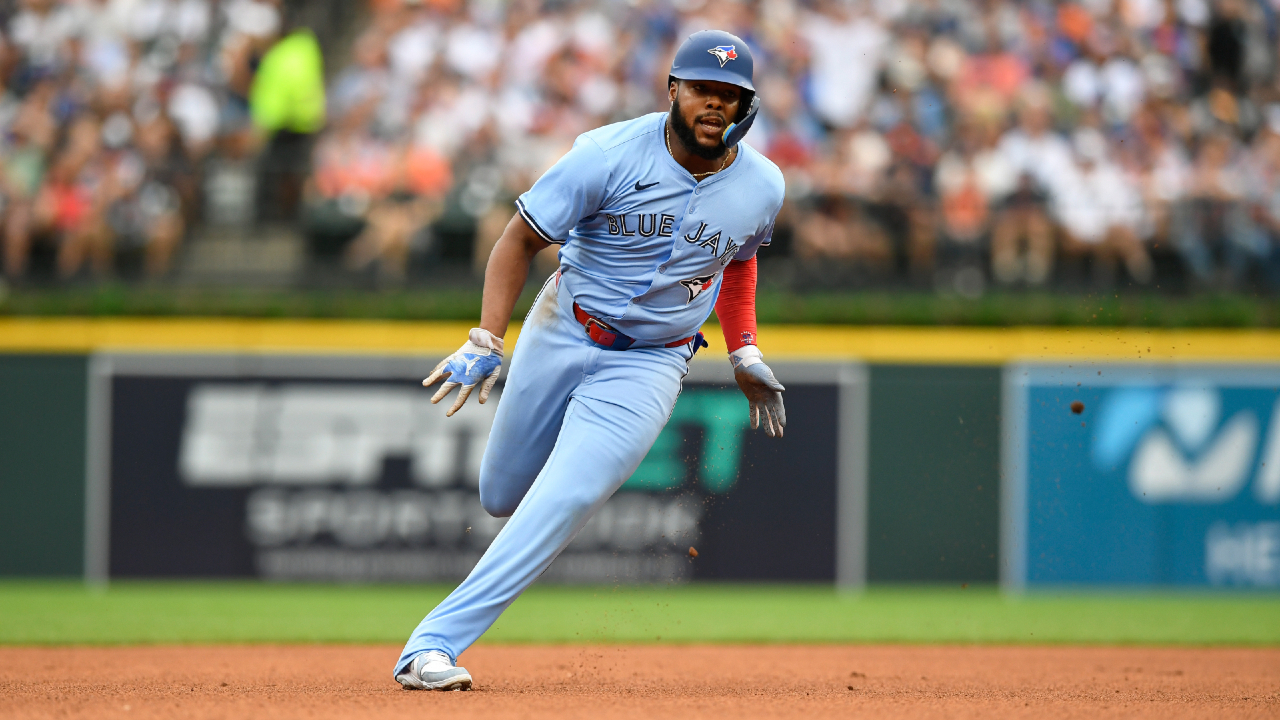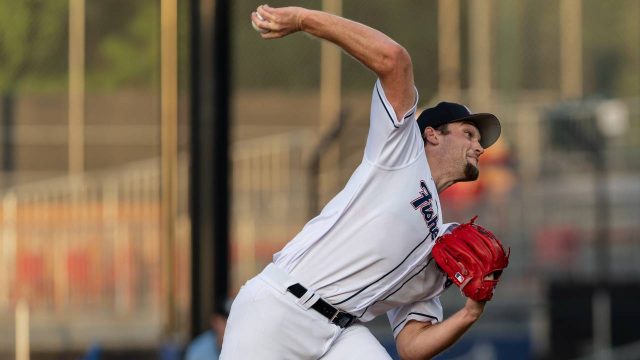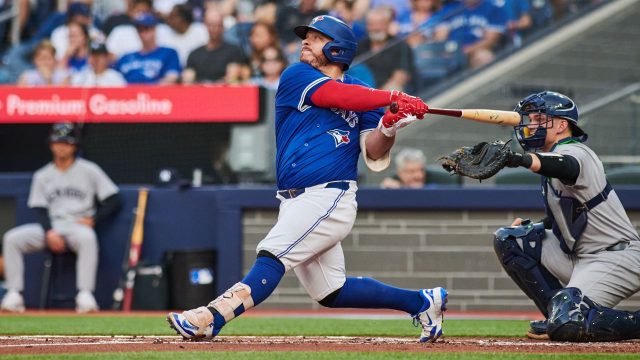
DETROIT — The 7-1 post all-star break run the Toronto Blue Jays were on entering Saturday’s play, in which the club hit .310 and OPS’ed .870 with a 12.3-per-cent strikeout rate straight out of the early-80’s, would have been impressive against anyone, let alone the run of all-stars, ERA champs, and Cy Young winners they encountered.
A week ago Friday, Toronto didn’t let Justin Verlander out of the second inning, tagging him for four runs on nine hits while holding the future hall-of-famer without a strikeout for only the sixth time in his 543-start career. The next night, the Blue Jays got four runs on 11 hits off perennial Cy Young candidate Logan Webb, striking out just once. The last time Webb had fewer than three strikeouts in a start was 2023, a span of 59 outings.
A night later, it was Robbie Ray surrendering season highs in runs, walks, and homers, finishing with his lowest game score (31) in an outing since last August when he was returning from Tommy John surgery. The night after that, Carlos Rodon tied his season low in strikeouts (one of the other times was also against the Blue Jays) while setting a season high in walks and allowing four runs over an arduous five innings.
And finally, on Wednesday, the Blue Jays handed Max Fried his worst start in two months, bleeding him for six runs over 5.1 innings while going even in strikeouts and walks with three apiece. It was only a marginally better performance than the one they had against Fried earlier this month, when they cashed four runs in six innings with a pair of strikeouts and walks.
“Those are some good pitchers,” Blue Jays manager John Schneider said prior to Saturday’s game. “I feel like sometimes when pitchers are big strikeout pitchers and they don’t really get that result, it affects the cadence of their outing. Not that it frustrates them, but it’s probably a little bit of a different feel. So, I think when you’re facing really good pitchers, you have to put the ball in play. You have to hit some mistakes. And you have to run the bases really well.”
Facing yet another demon on Saturday in Tarik Skubal, the Blue Jays had an opportunity to add another piece of taxidermy to the mantlepiece but were let down by that third factor — baserunning — as they allowed the Detroit Tigers ace to escape multiple jams and skate away with six shutout innings.
But thanks to Toronto’s collectively belligerent plate approach, which has produced MLB’s best contact rate and a top-10 slugging percentage (two things that typically trend mutually exclusive), the Blue Jays got Skubal out of the game and exploited Detroit’s bullpen late, plating two in the eighth and three in the ninth to run away late with a 6-0 victory.
The big eighth-inning swing came from Bo Bichette after Joey Loperfido and George Springer reached on singles and advanced into scoring position on a wild pitch. After putting up one of the best plate appearances of Toronto’s season against Skubal — more on that later — Bichette took two looks at Will Vest’s sinker before shooting a third the opposite way through a drawn-in infield to plate the game’s first two runs.
And the big ninth-inning swings came from Nathan Lukes, Springer, and Vladimir Guerrero Jr., who all hit no-doubters into the night off Chase Lee. For Springer, it capped a second consecutive three-hit game and gave him 11 hits in 21 at-bats over his last five. Suddenly, MLB’s winningest team was in another laugher, as a “Let’s Go, Blue Jays” chant began ringing around Comerica Park.
No runs had been scored to that point thanks to Skubal being Skubal, and Kevin Gausman being vintage Kevin Gausman, allowing only a hit and a walk while striking out 10 over six innings. Gausman ran up a season-high 21 whiffs — 13 with his splitter — while living on the plate with a fastball he located in the zone nearly two-thirds of the time. Even his slider, Gausman’s third-best pitch, was a weapon, getting five whiffs and two foul balls on seven swings.
Meanwhile, the Blue Jays put runners on against Skubal — who has a legitimate case as baseball’s best pitcher going — in four of his six innings. But none of the eight Blue Jays to reach crossed the plate, thanks partly to what Skubal did to the Blue Jays in big spots, and partly to what the Blue Jays did to themselves.
A promising opportunity materialized in the third, as Guerrero Jr. lined a single to the opposite field before Bichette rang a double to left, putting two runners in scoring position with one out.
But as Tyler Heineman — pinch-hitting for Alejandro Kirk, who left the game after taking a foul ball off the mask — feinted a bunt in a 2-1 count, Guerrero strayed too far off third and was back-picked by Jake Rogers. And after Heineman walked, Addison Barger grounded out on a first-pitch sinker to end the threat.
The Blue Jays put two on again in the sixth thanks to a soft single off the end of Springer’s bat and a diligent Guerrero walk. That brought up Bichette, who worked the plate appearance of all plate appearances, forcing Skubal to throw 13 pitches — he fouled off nine of them all around the zone, including 100-m.p.h. fastballs, 90-m.p.h. changeups, and even an 84-m.p.h. curveball — before drawing a walk.
An effort like that against any big-league pitcher is ridiculously impressive. But an effort like that against Skubal? Unheard-of. It tied the longest plate appearance of Skubal’s career, a 13-pitch Manny Machado walk in 2022 (On July 27, 2022, incredibly, almost two years prior to the day).
And yet, the energy of Bichette’s inspired battle was quickly quashed as Springer, caught in between tagging and running home from third on a Heineman looper to shallow centre, was gunned out at home on an awkward play after the ball found grass. Springer appeared to slow up down the line, foregoing a slide as he was tagged out a step from the plate.
Moments later, Skubal was roaring as he strode off the mound after getting Barger to look at a called third strike, 101 on the outside black. But what Bichette did to Skubal was what the Blue Jays did to Verlander, Webb, Ray, Rodon, and Fried before him, battling to the bitter end, running up a pitch count, and forcing an immensely talented arm from the game.
That let Bichette capitalize with runners on in the eighth, before Lukes, Springer, and Guerrero blew the roof off. Those home-run swings have come and gone this season. But what’s been consistent is Toronto’s ability to pack a lunch pail and battle with the best pitchers in the league.
Toronto hitters own baseball’s highest contact rate, which has produced a 17.3-per-cent strikeout rate that ranks as the lowest of any team since 2018. And if you really want to get into the weeds, you can normalize that strikeout rate in relation to the league average, and suddenly you find the Blue Jays tied for the third-lowest since 1949, which is as far back as reliable data goes.
Only three teams have fouled off a higher percentage of the pitches they’ve seen this season, and no team has spoiled a higher percentage of pitches outside the zone. Swinging at stuff off the plate isn’t generally a great strategy, but it can be when you’re whiffing on those pitches at a league-low rate and posting a league-high batting average against them, as the Blue Jays are.
They just won’t give away easy outs. The Blue Jays have MLB’s highest batting average, lowest whiff rate, and highest foul rate on two-strike pitches this season. The same goes for two-strike pitches outside the zone, except the margins between Toronto and the second-place team only get wider.
Ace or not, nasty stuff or not, owning the edges or not, a pitcher can’t count on their bat-missing ability to eliminate the impact of defence, ballpark, and luck against the Blue Jays. Even Skubal, a guy with strikeout, walk, whiff, chase, and hard-hit rates within MLB’s 92nd percentile or higher, was gotten to eventually. Every good offence needs an identity. Call it tenaciousness, call it belligerence, call it obstinance — the Blue Jays have theirs.






